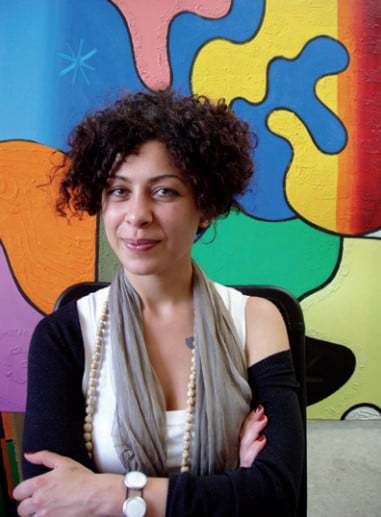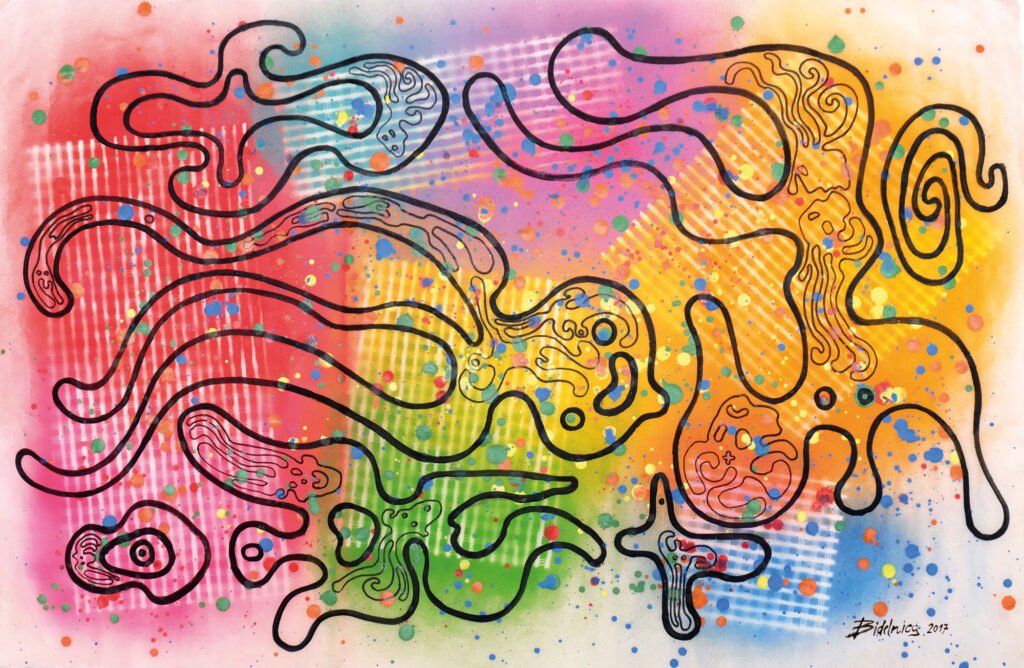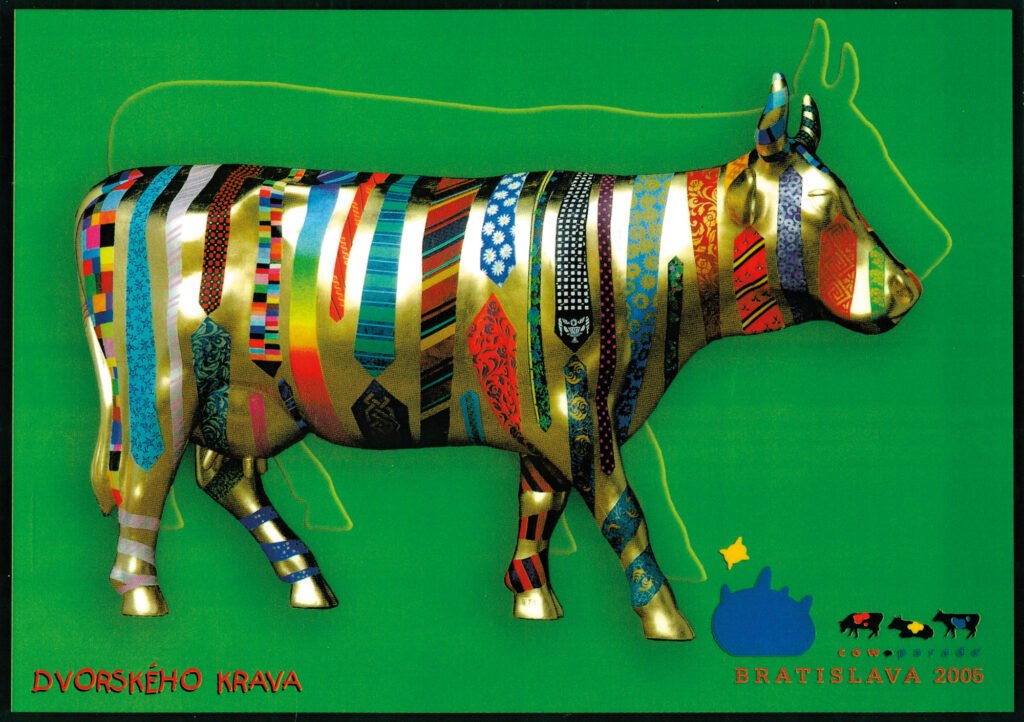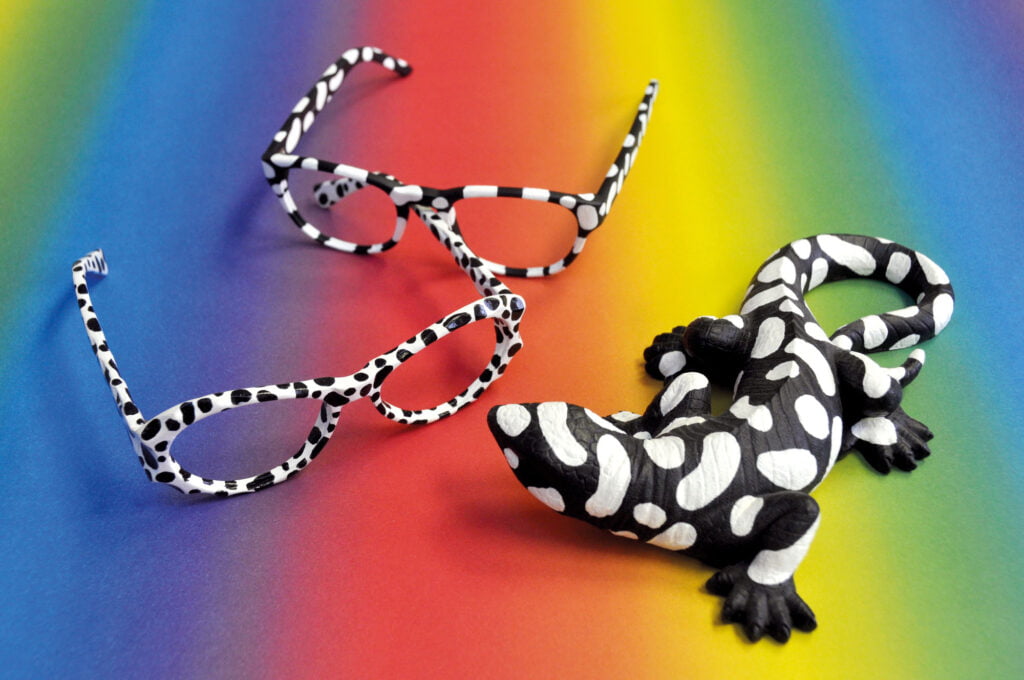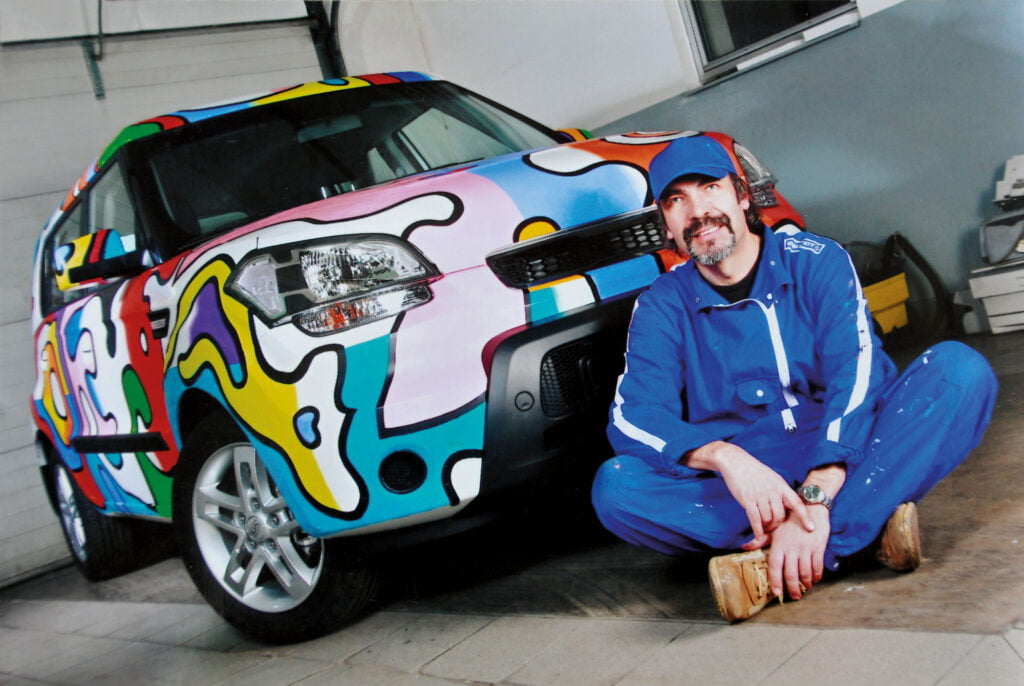Zuzana Neumannová o Danielovi Bidelnicovi

Mgr. Zuzana Neumannová
Mgr. Zuzana Neumannová
BIOSVET ALEBO NA NEBI, POD VODOU A NA ZEMI
Vo veľkom okruhu maľby posledných rokov sa pokúša tematicky zaznamenať univerzálny biosvet, ktorý tvorí všetko živé a neživé, čo nás obklopuje. Dotýka sa otázok života a existencie, podstaty bytia človeka na zemi či vo vesmíre. Rieši univerzálne, základné morálne a etické témy týkajúce sa medziľudských vzťahov. Prináša vlastnú vizualizáciu svojej predstavy všeobecne nezodpovedaných filozofických i náboženských tém, dotykov s pozemským i nebeským. Konfrontácia s týmto večným konfliktom privádza autora k istej výtvarnosti, symbolickej a dynamickej farebnosti, organickému tvarosloviu, riešeniu figúr a tvarov na univerzálnom pozadí, až do ich „vesmírneho“ splynutia. Rieši otázky dobra v kontroverzii so zlom, kolobeh ľudského života aj príbeh jedinca, vzťah človeka k prírode ako základnej fyzikálnej veličine. Priznáva sa k motivácii prírodnými živlami, ktoré v autorovej filozofii predstavujú oheň, voda, vzduch a zem. V ich symbióze vzniká všetko. Cyklus Biosvet predstavuje autorské názorové vyznanie. Obrazy v ňom sú inšpirované organickými tvarmi abstrahovanými do podoby archetypálnych figúr, naznačených ľudských alebo zvieracích animálnych bytostí, vegetačných rastlinných útvarov. Sú poprepájané a zmietané vyššími silami prírody v neznámom a tajomnom priestore. Vytvára mytológiu tvarov a vzťahov na dvojrozmernom plátne. Jednota bytia nerozlišuje hore ani dole, blízko ani ďaleko, navyše všetko má rovnakú intenzitu farebnosti. Vo svojich predstavách sa dotýka vzniku samotného života, večného boja dobra so zlom, kolobehu života človeka, keď do pomyselného priestoru umiestňuje náznaky figúr, bytostí symbolizujúcich tieto procesy. Organické prepojenie tvarov a pozadia, tvarová prepletenosť, spojenie pozitívneho a negatívneho, strata horizontu a hĺbky umožňuje na obrazy nazerať horizontálne aj vertikálne, hocijako. Predstavujú syntézu vyjadrenia tejto problematiky. V rámci témy Biosvet uplatňuje výtvarné prostriedky popartového repertoáru, ale aj streetartové inšpirácie. Objavuje sa v nich geometrizujúce tvaroslovie, formálny, ale aj tematický pozvoľný prechod k abstrakcii.
GEOMETRICKÁ ABSTRAKCIA
Dominantnou líniou Bidelnicovej tvorby posledných rokov je abstraktná maľba, dôsledne variujúca geometrické výrazové prvky. Vykryštalizovala a ustálila sa vo využívaní základných tvarov štvorcov, kruhov, obdĺžnikov, liniek a čiar v nekonečných otvorených kombináciách, vzájomných vzťahoch, alebo s pozadím. Pojednáva ich vo svojej typickej farebnosti, aj vo vzťahoch s bielou, čiernou a sivou. V tomto základnom vymedzení výrazových prvkov rozpracúva niekoľko základných tém.
ČIAROVÉ KÓDY
Jednou z možností postupnej geometrizácie tvarov a budovania obrazovej štruktúry je používanie čiary – linky ako minimalistického prvku. Parafrázuje a rozvíja tému obchodných čiarových kódov. Vytvára svet nových umeleckých kódov pre svoje umenie. Pristupuje k nim ako k výtvarnej téme. Paralelné farebné čiary na obrazovej ploche rieši v netušených možnostiach kombinácií a hľadania vzťahov hrúbky čiar, plôch a farebnosti, svetlých a tlmených farieb, pokračuje verziami rozstrihaných, rozrezaných kódov. Množstvo kombinácií predstavuje autorskú prácu s kódom, hru s jeho princípmi. Poetika spočíva v efekte posunu čiar v kombinácii s tóninou farebnej škály.
ŠTVORCE
Rozsiahly okruh Bidelnicovej tvorby je venovaný práci so štvorcom, základným geometrickým prvkom. Čistota tvaru štvorca vyjadruje podstatu, substanciu, buduje obrazový priestor. Dáva kreatívny potenciál pre konfigurácie, nekonečné multiplikácie štvorcov a spájanie obrazov s variovaným motívom a farebnou nadväznosťou do veľkých celkov. Využívanie týchto princípov umožňuje opakovaním jedného prvku vytvárať monumentálne obrazy, s nevyčerpateľným množstvom možností. S témou štvorca autor pracuje v rôznych súvislostiach. Jedným z variantov je postavenie tvarov štvorca vo štvorci v protichodných farbách, ktoré opticky vytvárajú kontrasty a zároveň sú vo vzájomnej harmónii. Farby postavené vedľa seba sú volené zámerne, autor využíva zákonitosti optiky (schopnosť oka vnímať farby spektra) aj chromatiky (teória o zákonitostiach používania základných a doplnkových farieb). Iným riešením je variovanie štvorcového rastra prekrytého namaľovanou farebnou mriežkou s kruhovými otvormi s cieľom dosiahnuť zámerný optický efekt. Ďalšie predstavujú „malevičovské“ vymedzenia štvorca voči štvorcu na ploche dvojrozmerného obrazu. Úvahy o tvare štvorca sa premietajú do samotného štvorcového formátu obrazov, ktorý mu umožňuje multiplikáciu a ich nadväzné radenie. Štvorcový obraz, rozdelený na štyri polia, rieši vo viacerých cykloch. Rozvíja motív nadväznosti a pokračovania zvoleného motívu vo farebnosti, štruktúrach, prípadne v ďalšom delení plochy na malé štvorce. Geometrické členenie a následná rytmizácia sú predpokladom a prostriedkom pre monumentálne kompozície. Do obrazu vnáša bielu a čiernu farbu, pridáva štruktúry s použitím piesku, drviny, ťahy špachtľou, horizontálne alebo vertikálne členenie niektorých štvorcov, i vložený tvar trojuholníka. Spojenie okrúhlych formátov obrazov so štvorcovou farebnou šachovnicou je premostením k téme geometrického tvaru kruhu.
QR KÓDY
Motív štvorca spájaný s písmom posunul neskôr k súčasnému riešeniu QR kódov, vychádzajúc z geometrického zobrazovacieho princípu z bežného života. Aplikuje ho na „QR kódové“ riešenie svojho mena a priezviska vlastnou výtvarnou interpretáciou na úkor reálnej technologickej čitateľnosti, ktorú podriadil svojej koncepcii výtvarnej poetiky, a týmto vytvára svoje vlastné synonymá doby.
KRUHY A PLANETÁRIUM, ALEBO DO KRUHU
Inšpirácia tvarom kruhu je premietnutá do rozsiahleho a rozmanitého cyklu s identickým názvom Do kruhu. Základný tvar prechádza autorským spracovaním, vytvára vlastné kruhy vo vlastnej interpretácii a osobitom umeleckom pojednaní. Významovo sa kruhy stávajú inými, keď pôvodný vymedzený kruh je na svojej ploche konfrontovaný s inými kruhmi, alebo ich výsekmi v rôznych kompozíciách. V obraze kruhového formátu sa môžu ocitať čiary, špirály, kresba. Konfrontácia prebieha aj s tvarom štvorca, dochádza tak ku kontrastným pozíciám štvorca umiestneného v kruhu. Potenciál týchto možností využíva a rozpracúva v celej škále svojej typickej farebnosti a štruktúrnom poňatí obrazovej plochy. Umiestňuje aj asymetricky položené kružnice, ktoré vytvárajú dojem zakreslených dráh pohybu vesmírnych telies, či pripomínajúcich astrálne mapy. Čitateľná je motivácia historickými terčmi. Pohrávanie sa s konkávnymi a konvexnými čiarami prechádza aj do trojrozmernej kompozície vrstvených kruhov. Vizuálny efekt je odkazom na opartový vizuálny koncept a autonómny autorský program.
PLANÉTY
Do témy kruhu v nadväzujúcom cykle Svetlá a tiene prináša novú, snovú polohu, interpretujúcu predstavy o vesmírnych svetoch. Vytvára svoje planetárium, obrazové observatórium priestorov s planétami, ktoré sleduje na imaginárnych obežných dráhach, zoskupené v neznámych súhvezdiach. Sú umeleckým zhmotnením úvah a predstáv o svete. Planéty rieši ako farebné body na pozadí, obrazovú plochu ako oblohu plnú hviezd a sĺnk ako zdrojov svetla. Vesmírne svety vytvára výlučne súčasnými technikami airbrushu, striekaním na podmaľbu, keď sa inšpiruje technikami streetartu. Využíva aj techniku dripingu a neónové farby, čím podporuje mystické, tajomné významy vesmírnych výjavov.
OBJEKTY
Stopy výtvarného konceptu, dominantne typickej farebnosti, autor premaľúvaním vtláča predmetom dennej potreby, architektonickým prvkom a širšie dotvára urbánne prostredie. Zaujímavou je oblasť bodypaintingu. Premaľúvanými objektmi sú trofeje, škrabošky, parožia, masky, sudy, okuliare, korytnačky, prasatá a iné zvieratá. K ich premaľovaniu pristupuje individuálne, sú zbierkovými objektmi, často vytvorenými na objednávku. Zaujímavou skupinou sú premaľované busty antických sôch alebo búst známych osobností. Týmto ich dostáva do inej roviny výrazu a významu.
EXTERIÉROVÉ OBJEKTY
Trojrozmerné predmety uplatniteľné v exteriéri nemajú priamo sochársky charakter, budované sú na princípe ready-made. Kovové, keramické či drevené predmety, cielene zoskupené, premaľúva alebo dopĺňa inými atribútmi, pridáva farebnosť, autorsky nimi manipuluje a nanovo ich pretvára. Tvorba posledných pätnástich rokov je silná, konzistentná a vyhranená. Prijíma nové, zároveň to podriaďuje svojej koncepcii. Napriek novým médiám, ktoré akceptuje, dominantná je autonómna umelecká výpoveď. Drží sa vlastnej farebnej palety, ktorá je vždy rozpoznateľná a predstavuje typický autorský „kód“ Daniela Bidelnicu. Rovnako ako cit pre veľké témy riešené vo veľkých formátoch. To všetko robí charakteristický vizuál tvorby Daniela Bidelnicu jednotným a neprehliadnuteľným.
Mgr. Zuzana Neumannová
THE BIO-WORLD OR IN THE SKY, UNDER THE WATER AND ON EARTH
The artist has been trying to record the universal Bio-World, which consists of everything living and non-living that surrounds us, thematically rendered in a large cycle of paintings of recent years. He touches upon the questions of life and existence, the essence of human beings on earth or in space. Bidelnica deals with general, basic moral and ethical themes related to human relationships. He presents his own visualisation of the idea of generally unanswered philosophical and religious themes, touches upon the earthly and the heavenly. Confrontation with this eternal conflict inspires the artist to employ specific creativity, symbolic and dynamic colours, organic morphology, the composition of figures and shapes against a universal background until their “cosmic” fusion. The artist resolves the questions of good in confrontation with evil, the cycle of human life and the story of an individual, the relationship between man and nature as a basic physical quantity. He admits being inspired by the elements – fire, water, air and earth – which represent his philosophy. Everything is created in a symbiosis. The cycle Bio-World expresses the artist’s personal opinion. The images are inspired by organic shapes, abstracted in the form of archetypal figures, sketchy human or animal figures, and vegetation forms. They are interconnected and swept by stronger forces of nature in an anonymous and mysterious space. He creates the mythology of shapes and relationships on a two-dimensional canvas. The unity of existence does not differentiate between up and down, near and far, moreover, everything has the same colour intensity. In his perception, he touches on the origin of life itself, on the eternal struggle between good and evil, the cycle of human life, placing sketchy figures, beings symbolising these processes in an imaginary space. The organic connection of shapes and the background, interweaving shapes, the relation between the positive and the negative, the loss of horizon and depth allows the images to be viewed both horizontally and vertically. They represent the synthesis of the expression of this subject matter. As part of the Bio-World theme, he uses expressive devices of the Pop art repertoire, but also Street art inspiration. They reveal geometric morphology, aformal but also thematically gradual transition to abstraction.
GEOMETRIC ABSTRACTION
The dominant line of Bidelnica’s work in recent years has been abstract painting, consistently varying expressive geometric elements. It takes the form of the elementary shapes of squares, circles, rectangles and lines in endless open combinations, in mutual relationships or against the background. He treats them in his typical colour scheme, and also in relationships with white, black and grey. In this basic definition of expressive elements, he develops several fundamental themes.
BAR CODES
One of the possibilities for the gradual geometrising of shapes and the building of the pictorial structure is the use of the line as a minimalistic element. Bidelnica paraphrases and develops the theme of commercial business bar codes. He creates a world of new artistic codes for his art and treats them as an artistic subject. He arranges parallel coloured lines on the image surface in unanticipated combinations and searches for relationships of line thickness, surfaces and colours, light and subdued colours, and continues with versions of cut through and cut codes. The number of combinations represents the artist’s work with the code, playing with its principles. His poeticism consists in the effect of shifting lines in combination with colour.
SQUARES
A wide range of Bidelnica’s oeuvre is devoted to work with the square, the fundamental geometric form. The purity of the shape of the square expresses the essence, builds the pictorial space. It develops a creative potential for configurations, endless multiplications of squares and connections of images with a varied motif and colour continuity into large units. The use of these principles makes it possible to create monumental pictures by repeating one element. The artist works with the theme of the square in various contexts. One of the variants is the arrangement of the square shapes in a square in contrasting colours, which optically create contrasts and at the same time are in harmony with each other. The colours arranged next to each other are chosen deliberately because the artist makes use of the laws of optics (the scientific study of light and the way we see) and chromaticity (the quality of a colour regardless of its luminance). Another composition is to vary the square grid overlaid with a painted coloured grid with circular openings with the aim of achieving a deliberate optical effect. Others represent “Malevich’s” definitions of a square in a square area on the surface of a two-dimensional image. Reflections on the shape of the square are reflected in the square format of the pictures, which allows multiplication and sequencing. Bidelnica composes the square image divided into four areas in several cycles. He develops the motif of continuity and continuation of the chosen motif in colours, structures, and possible further divisions of the area into small squares. Geometric composition and a subsequent rhythmical arrangement are a prerequisite and a means for monumental compositions. He introduces into the picture white and black, adds structures using sand, rubble, spatula strokes, horizontal or vertical arrangements of several squares, and an inserted shape of a triangle.
QR CODES
The motif of the square associated with lettering later evolved into the current arrangement of QR codes, based on the geometric depiction principle from everyday life. He applies it to the “QR code”, using his first and last name and his own artistic interpretation at the expense of real technological legibility, which he subordinated to his concept of creative poeticism.
CIRCLES AND THE PLANETARIUM OR INTO THE CIRCLE
The inspiration of the shape of the circle is reflected in an extensive and diverse cycle with the identical title Into the Circle. The basic shape defined by the artist creates its own circles in his own interpretation and distinctive artistic rendering. The significance of the circles becomes different when the original circle is confronted on its surface with other circles or their sections in different compositions. Lines, spirals, and drawings can be found in the circular image. Confrontation also takes place with the shape of the square, thus contrasting positions of the square placed in the circle appear. The artist uses and develops the potential of these possibilities in the whole range of his typical colour and structural concept of the picture area. He also composes asymmetrically arranged circles, which create the impression of drawn paths of movement of cosmic bodies or resemble astral maps. Playing with concave and convex lines also transforms into a three-dimensional composition of layered circles. The visual effect is a reference to the Op art visual concept and autonomous artist’s agenda.
PLANETS
The artist adds a new, dreamlike position to the theme in the subsequent cycle Lights and Shadows interpreting the ideas about cosmic worlds. He creates his planetarium, a visual observatory of spaces with planets, in which he observes imaginary orbits grouped in unknown constellations. They are an artistic materialisation of thoughts and ideas about the world. The artist depicts the planets as coloured points on the background, the image area as a sky full of stars and suns as sources of light. He creates cosmic worlds exclusively with contemporary airbrush techniques, spraying the underpainting, drawing inspiration from Street art techniques. He also uses the technique of dripping and neon colours, which endow cosmic scenes with mysterious meanings.
OBJECTS
Traces of the artist’s concept and dominant signature colours are imprinted in repainted objects of daily use, in architectural elements and also in the finishing touches put to the urban environment. The area of body painting is of particular interest. Repainted objects are trophies, dominoes, antlers, masks, barrels, glasses, turtles, pigs and other animals. They are repainted individually as collection items, and are mostly commissioned. An interesting group of works includes repainted busts of ancient sculptures or famous personalities.
OUTDOOR OBJECTS
Three-dimensional outdoor objects based on the ready-made principle do not have an exclusively sculptural character. The artist purposefully groups metal, ceramic or wooden objects, repaints and complements them with other attributes, adds colour and manipulates them in an original way. The work of the last fifteen years is impressive, consistent and specific. The artist responds to new stimuli, yet subordinates them to his concept. Despite the new media he accepts, his distinctive artistic expression is dominant. Daniel Bidelnica continues to use his own colour palette, which is always identifiable and represents his signature “code”, and a feeling for universal themes composed in large format. The characteristic visual image of Daniel Bidelnica’s work is unified and bears his unmistakable imprint.
Mgr. Zuzana Neumannová

